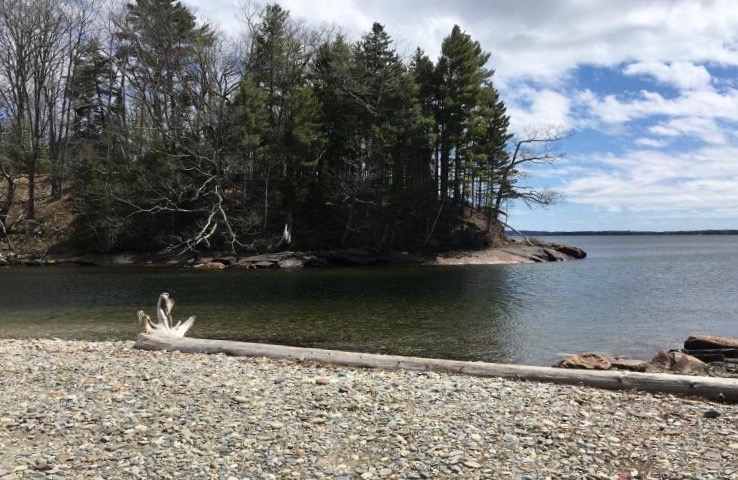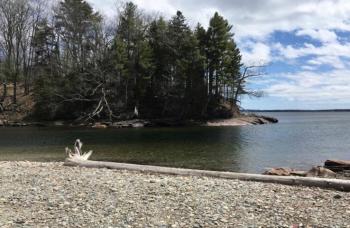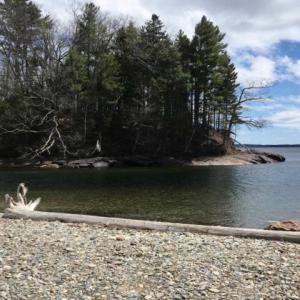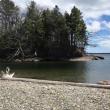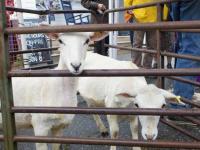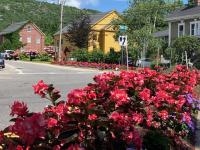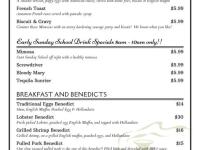This Week in Lincolnville: On the Shores of the Penobscot
According to lore the Penawapskewi Bear Clan resided on the west shores of what is now known as the Penobscot Bay. The abundance of fish, water fowl and game kept entire villages fed. The smoking of these items with the summer and fall south west breeze and the abundance of cherry wood led to delicacies that endure to this day with Ducktrap Smoked Salmon, mussels and oysters (I think the pate was a French introduction).
Unfortunately not all the meats were delicacies: a seal is one tough fish, a bear even tougher and a wooly mammoth tougher yet and just plain too big to move.
As the last Ice Age retreated (back 20,000 odd years give or a take a decade or so) the people of the dawn would drive the mammoths over the edge of the glacier where they would fall on the rocks below. This led to a wildly anticipated celebration which would go on for weeks. Fires would be started to 'grill' up the most tender cuts of the mammoth but the heavy shoulders and ribs required weeks of intense smoke to make them edible. The spices and wet mops they used were good old horseradish and maple syru giving the slow smoked mammoth a sweet and spicy presentation.
CALENDAR
Note: if there is no link to a remote meeting, contact the Town Office or 763-3555 to get it
MONDAY, Apr. 26
Selectmen, 6 p.m., Remote
TUESDAY, Apr. 27
Lakes and Ponds Committee, 7 p.m., Remote
WEDNESDAY,Apr. 28
Library book pick-up, 3-6 p.m.
Planning Board 7 p.m., Remote
SATURDAY, May 1
Library book pickup, 9 a.m.-noon, Library
SUNDAY, May 2
LHS BBQ Take-out Dinner, 33 Beach Road (Beach Schoolhouse), pick up 1-3 p.m.
EVERY WEEK
AA meetings, Tuesdays & Fridays at noon, Norton Pond/Breezemere Bandstand
Lincolnville Community Library, curbside pickup Wednesdays, 3-6 p.m. and Saturdays, 9 a.m.-noon. For information call 706-3896.
Soup Café, cancelled through the pandemic
Schoolhouse Museum open by appointment, 505-5101 or 789-5987
Bayshore Baptist Church, Sunday School for all ages, 9:30 a.m., Worship Service at 11 a.m., Atlantic Highway, In person and on Facebook
United Christian Church, Worship Service 9:30 a.m. via Zoom
Now I will grant that the southern BBQ'ers have perfected slow cooking the pig and cow, but it does not undermine the fact that meats, wood fired and slow cooked on a sou’west breeze got their start right here on the shores of the Penawapskewi Bay.
So maintains Andy Young as he gears up for next week-end’s Lincolnville Historical Society’s Barbecue Take-out Dinner. The meals, 150 of them, are already sold out: ribs, pulled pork and brisket, coleslaw, cornbread and cookies. He’ll be up all night next Saturday at the Beach Schoolhouse, tending the fires, slow cooking those rubbed and seasoned meats.
Beach dwellers, who’ve gotten used to the delicious smells of Green Tree Coffee Roasters wafting through their neighborhood will wake up Sunday to the scent of barbecued meats. If the wind’s right we may even get a whiff up here in Sleepy Hollow.
Now Andy’s argument, persuasive as it is, that barbecue orginated right here at Ducktrap, may be dismissed by some. Woolly mammoths driven over the glacier’s lip? Hmmmmm. But evidence of the glacier is everywhere. We live atop its path.
Did you ever wonder where all these rocks came from, the ones that pop up every spring as the frost comes out, in the walls that mark boundaries, in the foundations of our old houses? How about the behemoths like Balance Rock? When the mile-thick glacier that covered Maine some 25,000 years ago began slowly receding and melting, it left behind the debris – rocks, sand, gravel – it had accumulated over the millennia as it spread across the land. And the heavy ice sheet left striations, scratches in the bedrock of Lincolnville’s shore. The bald tops of the Camden Hills (Bald Rock, Bald Mountain, Frohock, Cameron) were scraped clean down to the bedrock by the glacier. The thin soil filling cracks in the rock support only stunted trees and bushes, lichen and mosses.
To understand more about the topography of our town check out this piece from the Bangor Daily News on the Ice Age in Maine. Better yet, get a copy of Beedy Parker’s book A Natural History of Camden and Rockport. Her book is a treasure for anyone wanting to learn more about this complicated piece of land we live on.
But how about the early ones, the People of the Dawn Andy refers to? Archaeologist Harbour Mitchell wrote about his work in Lincolnville in Ducktrap: Chronicles of a Maine Village:
We escape to the shore for picnics on hot nights, not thinking perhaps, as the moon rises over the remains of our meal and bonfire, that we are not the first people to use this land. Native Americans were here for thousands of years before Europeans even knew this land existed. They too lived where we do, fished, dug clams, hunted deer, and ate along the same shore while the moon rose over all.
Ducktrap Harbor contains numerous Native American archaeological sites, and many more may exist in the interior of Lincolnville and Northport. Evidence from other areas in Penobscot Bay indicate they had a sophisticated wood working technology. Adzes, celts, axes and gouges made of stone (they used no metal) suggest a high dependence on wood and wood products. It may even be that the native population used large dug-out canoes for ocean travel, though none have ever been recovered. The stereotypical birch bark canoe, while very real, may have been a late development historically.
Their houses were probably round in shape and approximately nine feet across. More than likely, they served to shelter a small family of perhaps three or four individiuals – a nuclear group. The evidence for this comes primarily from outside the Ducktrap area because very few places here have not seen plowing or other historic disturbance to the soil that destroys all traces of the houses on the surface.
During the late Archaic Period (approximately 3000-5000 years ago) the native population, correctly called the Moorhead Phase, but popularly referred to as the “Red Paint People”, lived here along the shore of Ducktrap Harbor. This population is known to have included skilled ocean fishermen who, based on the evidence from Penobscot Bay, hunted for large and dangerous animals such as swordfish. The warmer ocean temperatures at that time brought swordfish into the Gulf of Maine.
While rare, stone tools associated with the Late Archaic Period have been recovered at least one site at Ducktrap Harbor. Other artifacts from the period such as harpoon points and foreshafts made from swordfish bills, as well as the bills themselves, have been found elsewhere at coastal sites in Penobscot. Bay.
Often along the eroding shoreline evidence of ancient campsites are readily visible as shell “heaps” or middens, meaning refuse piles. These shell middens, the remains of clam dinners eaten in the same place for hundreds, possibly thousands, of years, are very delicate and cannot stand much disturbance. In the past it was common for collectors to tear these shell middens apart for their content of stone and bone artifacts. Unfortunately, both nature and collectors, acting unimpeded for centuries, have taken their toll, and very few intact shell middens are left. In Ducktrap there are virtually no shell middens left undisturbed.
In addition to clams, many fish species are represented in Ducktrap’s archaeological record. Shad, alewife, cod and haddock bone have all be recovered, even sturgeon. Although perhaps unfamiliar to us, during the early European presence and up to the late 1800s, sturgeon fishing was an important part of the Gulf of Maine’s commercial fishery. Though not widely considered in our menus, sturgeon was an important addition to Native American’s subsistence. A fully mature Atlantic sturgeon weighing in at over 600 pounds, may carry roe or eggs, has a very high oil content, and contains little bone. These qualities give the sturgeon a value that is potentially greater than that of any other animal commonly thought of as mainstays of the Native American diets such as deer or moose.
Have you read Kerry Hardy’s book, Notes on a Lost Flute? Here’s some of what he says in the first chapter:
I grew up in Lincolnville, Maine, and like most of my fellow citizens living on the western shore of Penobscot Bay, I live on taken land. …. It was probably taken from the Lobster Clan of the Penobscot people. They might still be there today, except that as of 1756 the Massachusetts legislature was still paying a bounty of forty pounds for a Penobscot scalp. With a strong British fort nearby on the Georges, or St. George River, midcoast Maine was a dangerous place to be an Indian. By 1769, the Lobster Clan had retreated to Old Town and white people were calling the Camden Hills region home.
I want to emphasize this: the Lobster Clan was a family of real people. Their descendants, many of them sharing the surname of Mitchell, can still be found on Indian Island at Old Town, nearby in Canada, or intermarried with whites and living throught North America. They are not anonymous, imaginary, or untraceable; they are, instead, the rightful heirs who have been disinherited from the lovely Camden Hills where I grew up. I hide that inconvenient truth in a corner of my soul that might be called “white guilt”. I don’t deny that it’s part of why I’ve written this book.
However, it’s not the biggest part. Much more significant is the admiration that I’ve had since childhood for all Indians. …. I apologize if my use of the word Indian is offensive to some, but in my life it has carried only positive associations. To my mind, Indians were self-sufficient, respectful of nature, stealthy and observant almost beyond belief, and stoic in the face of adversity. For all these reasons,…. I would find it hard not to use the word.
Kerry goes on to talk about his Lincolnville childhood, hunting, fishing, making “dismal attempts” to snare rabbits or make pemmican out of “bitter acorns and insipid berries”. And then to lay out in words along with his own photos and drawings what he’s learned about the language, the ecology, and the culture of the Wabanki, the People of the Dawn. It’s a beautiful book.
This 39 square mile parcel of land we call home – Lincolnville, named in 1802 for an obscure Revolutionary general – holds as much fascination for me today (who arrived in 1970 an already grown woman) as it did that first summer.
With spring finally breaking the grip of winter, we can get out again, hike the trails, picnic at the Trap while watching the moon rise over the Bay. We can dig in the rocky, boggy clay the glacier left behind, ever hopeful of producing a garden full of vegetables, swatting mosquitoes and dodging black flies.
And we can think about the earliest people who every summer sought out “our” breezy shore to erect their summer shelters, to eat clams and smoke, maybe not mammoths, but sturgeon and haddock and cod to take back with them into Maine’s winter woods.
Town
Candidates for selectmen will be Ladleah Dunn and Keryn Laite Jr., both incumbents running again for the two open seats. There are four candidates for school committee: Poonsri “Ning” Sawangjaem, Seth Anderson, Beth Goodman, and Melissa Nowell. There were no candidates for openings on the budget committee or for the CSD board.
LCS
School resumes this week after spring break with most children attending “in person”, and a smaller number still doing “remote”. Fingers crossed, everyone will be back to regular school by next fall!
Beach Schoolhouse Renovation Project Takes Off
This Sunday’s BBQ Take-out, Pick-up Dinner winds up the winter’s fund-raising meals. Thanks to the volunteer cookie, bean and chili cooks, along with Rose Lowell’s contributions of chowder and muffins, Andy Young’s Piggy Back BBQ, McLaughlin’s Lobster Shack and Dot’s coleslaw and cornbread the Historical Society has a nice, healthy bank account to start renovations to the building they bought from the town last December.
For a dollar.
The first work to be done is structural, putting in temporary supports to the second floor this spring, followed by two permanent steel beams this fall. This will enable the LHS to open the Schoolhouse Museum to the public in late June. The west wall of the building, including the fire escape, is also on this early list, along with some electrical work inside. Money raised this winter – some $40,000! – will enable us to get a start on these projects.
We’re applying for grants this spring as well, and plan a capital campaign for the summer months. What looked like a bleak future for the Historical society last year at this time has blossomed into an outpouring of support to preserve Lincolnville’s last one-room schoolhouse both as the home of the LHS and a community gathering place. We’ve got lots of ideas for the months ahead, so stay tuned!
Event Date
Address
United States

